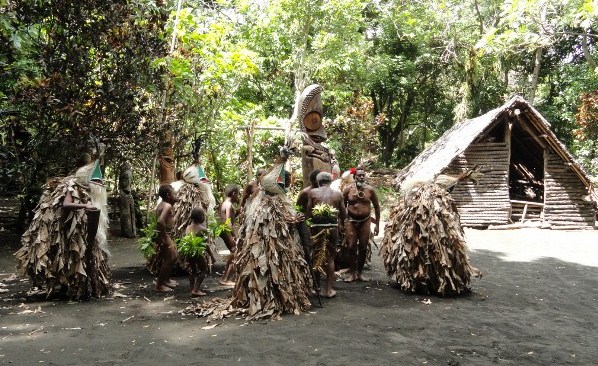Fanla Kastom

Rhiann Marie - Round the World
Stewart Graham
Sun 19 Sep 2010 02:01
|
Sunday September 19th 1230 Local 0130
UTC
16:06.8S 168:07.6E
We anchored up off the beach at Ranon in Ambrym and
it was not long before we had a visitor. Geoffrey came out in his dugout canoe
and chatted with us over a cold drink for a while.
We also went ashore to check him out and
to visit the village whci was very interesting. The people we have met in
Vanuatu are always smiling and say "hallo" but a little more shy than other
islanders we have met. There is also a very
confused situation with language here. At one time the French and the British
shared the colonial administration of the islands. As a consequence there were
two systems for everything, schools, prisons, hospitals law etc. Still today a
lot of people speak French or English. They also will speak there local language
and they will also speak Bislama which is a fully developed and written, pidgeon
English. The local languages number 105 in total! Apparently many opf them have
now been lost though. In the past every village stuck to its own territory and
no contact was made with other villages - unless you were hungry...... So over
many thousands of years they developed separate languages - completely separate
and they have to use Bislama today to communicate with each other. Most people
we met speak three or more languages.
Anyway back to Geoffrey in Ranon. We arranged with
him to guide us the next day into the jungle carpeteed hills to a remote
village called Fanla which was still run completely as a Kastom (traditional)
village. We arranged with the chief for them to perform a Rom Dance for us.
This dance is normally performed when the yam harvest is complete and is a
thanksgiving ritual.
We hiked up into the hills for about an hour and
then we arrived at the village. We sat in a family compound for a while and of
course attracted considerable interest from the locals. More and more peole
particularly children gathered to look at us. We were waiting for the signal
from the chief that they were ready to start performing the ritual dance on the
natsaro (traditional ceremonial area near the chief's hut and taboo
area.
It was quite primitive, yet haunting and I'm
sure it was performed this way for thousands of years. The men wore their
penises tied up in a small natural sheath called a namba, others were
shrouded in what looked like some sort of voodoo outfit. You really could
easily imagine cannibalism being performed here. See the photos.
It was Saturday morning and bizarrely in another
part of the village a Seventh Day Adventist service was going on and the hymn
signing could be heard in the distance. After the dancing we were shown their
ancient art of sand drawing and then traditional flute playing. Finally they
gave us a demonstration of the tamtam. These are giant carved vertical drums
which are used not only ceremonially but are used to signal to the chief various
messages when he is out in the bush. It was like something out of the "Jungle
Book". Here they were living just like that today.
The village had the distinct feel of a very
peaceful place and an idyllic harmonious (now they quit eating the neighbours)
though hard and basic life.
On Saturday afternoon we moved up to anchor of Fona
where we would vist the Granfather and Great Grandfather of Robert and the local
school.
|


